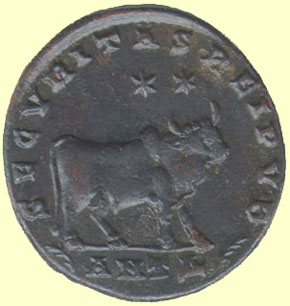 Contents -
Previous Article -
Next Article
Contents -
Previous Article -
Next Article
The image at right depicts the reverse of a coin of Julian. The bull is an image of Apis, a god popular in Egypt and the East at the time. Julian chose to signify his rejection of the Church by his wearing of a philosopher's beard and his striking of a coin flaunting the image of a Pagan god at a time when most of the government, including the emperors themselves, were overwhelmingly Christian. Julian and Gallus were two nephews of Constantine I that were not murdered after his death because Constantine's three sons decided that they were too young to pose much of a threat to their thrones. Much later, when Constantius II executed Gallus for corruption while he was governor of the eastern provinces, Julian was thrown in prison also. Julian was later released and regained the emperor's favor. In fact, he was even given the rank of Caesar in A. D. 355 and made governor of Gaul.
Julian proved to be an able and loyal administrator of the territory under his control. He also won victories against the barbarians, which made him very popular amongst the troops and people of Gaul. When Constantius decided to transfer many of the troops under Julian's command to the East to fight against the Persians in A. D. 360, they rebelled and declared Julian their emperor. Constantius went after him with an army but died while enroute. Julian mow assumed command of Constantius' troops and became emperor.
Julian reigned for only two years before he was killed in battle against the Persians. Upon hid death, the soldiers made Jovian emperor in his place.
Julian was a scholar and philosopher who committed his thoughts to writing. Some of his works are still extant today. He believed in the old pagan religion. and was the leader of the Neo-pagan Movement, which tried to reinstate the worship of the ancient pagan gods amongst the Romans. Though he had many followers, especially amongst the Senatorial classes, Christianity was too well established by this time to allow paganism to flourish again Though there were also later attempts to revive paganism, it was on its way out and was finally extinct in the Roman Empire by the time of Theodosius' death in A. D. 395. There is an excellent biography of Julian by Robert Browning titled simply The Emperor Julian.
Go to next article on Jovian
Go back to previous article on Vetranio